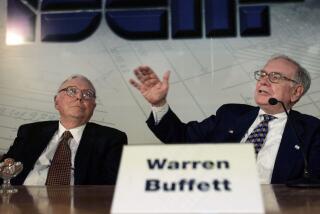‘Enron’ gives chilling view of greed run wild
“Enron: The Smartest Guys in the Room” is a horror film for adults. It’s a chilling, completely fascinating documentary that reveals the face of unregulated greed in a way that’s every bit as terrifying as Lon Chaney’s unmasking in “The Phantom of the Opera.” Maybe more so, because everything here is true.
What, after all, could be more frightening than the demise of Enron, a financial leviathan with assets of $70 billion that morphed into the largest corporate bankruptcy in American history? While insiders sold off stock worth hundreds of millions of dollars, 20,000 employees both lost their jobs and saw $2 billion in pension contributions disappear.
As written and directed by Alex Gibney (based on the first-rate book by Fortune writers Bethany McLean and Peter Elkind), “Enron” takes a candid look at what’s been called the corporate crime of the century. It was a fraud of such enormous proportions that Arthur Andersen, America’s oldest accounting firm, self-protectively shredded a ton of documents dealing with the case before going bankrupt itself.
Part of Gibney’s background (he wrote and produced “The Trials of Henry Kissinger”) is in progressive documentaries, but though the Enron case has strong political implications, this particular film couldn’t be further from the kind of rabble-rousing manifestos Michael Moore turns out.
Instead, in part because of the involvement of the book’s authors, “Enron” is as meticulously detailed and fact-filled a documentary as can be imagined. With interviews with many of the key players, as well as access to eye-widening corporate audio and videotapes, “Enron” is so thorough that you can’t afford to doze off (as many of the country’s financial institutions apparently did) even for a minute. Yet on the other hand the film knows the situation so thoroughly that, with the aid of occasional re-creations, it is able to make daunting financial complexities as clear as they’re ever going to get.
Another part of Gibney’s background is music (he produced the excellent blues-themed “Lightning in a Bottle”) and he has done some inventive things with “Enron’s” soundtrack. Unexpected songs like Billie Holiday’s version of “God Bless the Child” and the Lovin’ Spoonful’s “Do You Believe in Magic” make pointed appearances, and Gibney has the welcome nerve to begin the film with Tom Waits querulously rasping “What’s he building in there?” over a shot of Houston’s sleek Enron tower.
The question “Enron” sets out to answer comes in two parts. First, how did smart people like Chairman Ken Lay and CEO Jeff Skilling, shrewd individuals who liked to consider themselves the smartest people in any room, mess up the way they did? And, more to the point, how did the American financial establishment allow them to misbehave on such a colossal scale without so much as saying boo?
Lay, as it turns out, was an early proponent of deregulation, eager to liberate businessmen from pesky government rules. He had an eye for the big idea, such as the one that Enron took as its own: the notion that you could create a stock market for natural gas, could in effect turn energy into stocks and bonds.
What Enron also took as its own, unfortunately, was the social Darwinian notion of survival of the fittest. It more and more put earnings before scruples, deciding that any opportunity to make money was meant to be taken, even if it involved connivance and immorality. The top people at the corporation, increasingly convinced that perception was reality and fraud merely smart dealing, ended up the victims of their own hubris and greed.
One early example of this was the firm’s adopting of -- and accounting firm Arthur Andersen signing off on -- something called mark-to-market accounting. This easily manipulated system meant that you could book the hypothetical future value of a deal the day you signed it. It wasn’t long before Enron was doing things like booking $53 million of profit on a deal that ended up not making a single penny.
All this manipulation was in service of a strategy called “pump and dump”: keeping the Enron stock as high as possible so that major stockholders could cash in big no matter what the reality was.
Enron’s strategy for keeping those who should have known that reality, people like investment bankers and stock analysts, from finding out the truth was simple: It paid them so much money in commissions they had no incentive to look at things closely. The film calls this “synergistic corruption” and sees it as the prime reason the scandal got so out of hand.
One prominent victim of the amoral way Enron did business was the state of California. Taking full advantage of the state’s newly deregulated energy market, Enron’s ferociously aggressive traders created artificial energy shortages, which led to rolling blackouts, which led to Enron being able to charge exorbitantly for energy. It was a strategy that ended up costing the state $30 billion and led directly to a certain actor’s gubernatorial career.
As it piles details upon details, “Enron” makes it clear that this corporation’s situation was an accident not waiting but pleading to happen. Given that, as one observer puts it, Enron was “a house of cards built over a pit of gasoline,” it is amazing it survived for as long as it did without crashing and burning.
Whether Enron’s eventual catastrophe was the work of “a few bad apples” or, as the film posits, “the dark shadow of the American Dream,” is left for the viewer to decide. But it is impossible to watch this riveting story without concluding that a few regulating bureaucrats would be a small price to pay to prevent a cataclysm of the magnitude of Enron’s fiery self-immolation.
*
‘Enron: The Smartest Guys in the Room’
MPAA rating: unrated
Times guidelines: adult subject matter
An HDNet Films production, released by Magnolia Pictures. Director Alex Gibney. Producers Alex Gibney, Jason Kliot, Susan Motamed. Executive producers Mark Cuban, Todd Wagner, Joana Vicente. Screenplay Alex Gibney. Cinematographer Maryse Alberti. Editor Alison Ellwood. Music Matt Hauser. Narrator Peter Coyote. Running time: 1 hour, 50 minutes.
In limited release.
More to Read
Only good movies
Get the Indie Focus newsletter, Mark Olsen's weekly guide to the world of cinema.
You may occasionally receive promotional content from the Los Angeles Times.











